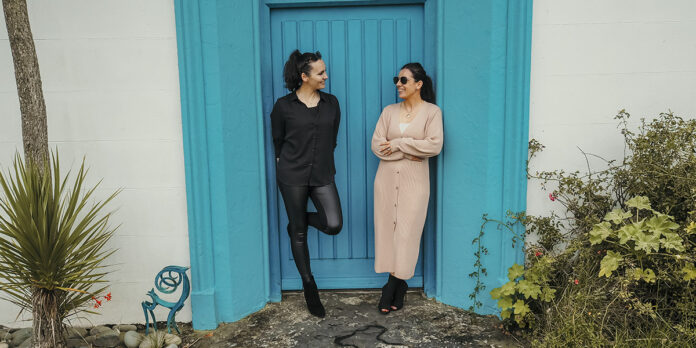Kilbaha Gallery marks a decade in business on the Loop Head Peninsula this year. Established in 2014 by sisters in law Liz Greehy and Ailish Connolly, it lies across the road from where Liz grew up and where her brother, sculptor Seamus Connolly carries on the tradition of operating the family foundry. For the two women, setting up the art gallery was a natural and organic thing for them to do at the time.
“I grew up in the industry because my brother Seamus is a sculptor and my father [Jim] before him was a sculptor and there’s a bronze foundry in the family. So when Ailish married Seamus some years later obviously it is something we talked about as a family on and off. And we were certainly very familiar with the industry; we were both kind of living it without being artists ourselves so setting up the gallery seemed like a very natural and organic thing to do at the time and ten years on, it’s going strong, thank goodness,” Liz says.
And several of the pieces on display at the gallery are those sculpted by Seamus or are other artists’ sculptures which are cast at the Connolly commercial foundry because it is one of only two surviving foundries in Ireland. Liz cites the example of Tanya Nyegaard whose sculptures they carry. Ms Nyegaard ran a bronze foundry in Dublin until it closed last year, and that foundry had operated for 140 years in the city before it shut down so now, she is doing her pieces at the Connolly foundry.
The Kilbaha Gallery represents highly regarded national artists such as Adam Pomery whose pieces hang in Ennis Cathedral, Bairbre Duggan who lectures in fine art in the Netherlands and has a holiday home in Kilkee, and Kaye Maahs from Ballybunion but who lives on the peninsula now and had her pieces selected by the RHA this year. All the artists on display at the gallery are Irish or Clare based or have a connection to the area.
“It is professional artists from all over Ireland but there is definitely a local edge to it though because we do have some of the most amazing artists in the locality. We are very lucky. There are about 55 artists that we represent,” Liz says.
As for the Loop Head Peninsula, it attracts exceptional artists and Liz and Ailish are grateful to have them in the locality. Kim Tittichai, Ruth Wood, Aideen Monaghan, Jackie McGrath and Christine Adam Pomeroy all call the peninsula home. Other artists who are Clare based include Fiona Ni Chuinn, Delaney Davis, Pauline Dunleavy, Vincent Killowry, and the artist who signs their work as ‘D’. In addition to fine art, Liz and Ailish retail their own Irish-designed and Irish-made attire featuring sweaters and beanies with their own distinctive ‘Break the Mould’ logo. Online, they also sell posters and e-books.
Prior to operating the gallery, Liz’s passion was in writing and she wrote about fashion for years; her interest was in the marketing and copywriting side of things, experience that has stood her in good stead because in selling online, strong writing describing product accompanies excellent images of the art. “Someone came in the other day to purchase a picture with a couple in it, and in the online description I had said they were ‘shoulder to shoulder against the world’ and they mentioned that to me – it resonated with them,” she recalls.
“Both of us have had our own backgrounds before life at the gallery. Ailish was very strong in sales and my interest was in business. My job was in writing but my interest was business. I grew up in the industry and Ailish married into it so we knew the industry very intimately. So, in a sense it made the perfect partnership where I would be strong on one area, Ailish would be strong in the other,” Liz explains. Ailish jokes she “promised a lot of stuff” when she married Seamus but never signed it, and that she and Liz are more tied legally than she is to Liz’s brother.
Liz and Ailish emphasise the curation involved in their work is in the choosing of the artists rather than the choosing of the work itself because they prefer to leave most of that to the artists themselves, because they trust them and they love their work.
“Some of our artists have been with us from day one, and there is a few of them that we chased to get into the gallery, but other artists have chased us,” Liz says.
The history of the site the gallery is situated on is culturally rich in terms of craftmanship, skill, artistry and the Irish language.
“If you go back in history to this area, the very original owner who would have pre-dated us if you like was a gentleman called Henry Blake and Henry was county Clare’s last native Irish speaker or certainly one of the last documented Irish speakers so he would have been born into speaking Irish which was kind of unusual because there was a little pocket of a Gaeltacht here for a very brief period,” said Liz. “Henry was extraordinary and he was a craftsman but he was more of a practical kind of craftsman in that he would make things like stools and chairs, súgán, and he also developed a love for boating and boats although he gradually lost his sight as he had had a bang to his head in his younger years and lost his sight as he got older. But he was still carving wooden boats as a blind man which was extraordinary so there was a lot going on with Henry and this would have been his workshop during his lifetime.
“Previous to Henry owning it, it was actually a cobblers at one point so there has been a lot of energy and an energy of making and doing.”
Although Henry Blake or Anraí de Blaca died in the mid 1970s, the two sisters-in-law can feel a certain energy at the site, even today.
“I think it must be the only gallery where you can see both the Shannon and the Atlantic from your front door so it has that amazing energy; there is an energy there,” Ailish adds.
Liz and Ailish remember the Covid years which proved challenging for the art gallery, and like many small and medium retailers across the country they had to act fast, adapting their business model by closing the coffee shop at the back of the premises and quickly filling it with art work. In retrospect, it was a positive thing for the arts side of their business however, they both joke they miss the cake testing that used to go on.
In the meantime, there are no current plans for expansion. “We have come back and forward with a lot of plans but I think Covid kind of disrupted things for us – not all bad by the way – it certainly focused us a bit more but we don’t have an immediate plan [to expand] but we would like to,” Liz says.
Meanwhile, they work wonders with the space available to them in order to effectively display the artwork, and unusually, large sculptures are in fact far easier to accommodate within their site because they are 3-D.
Aside from the challenges of space making, online sales are of vital importance especially in a remote area like Kilbaha. Because they have an online shop, they work all the time even when the gallery’s doors close in the evening or when hours reduce in the off tourist season. With four people including Liz and Ailish working at the gallery plus a photographer, tasks such as shipping, logistics and photography are equally as important as in-person sales. In addition, Ailish operates a ‘first look list’ so when new pieces come in, interested people and potential buyers are given a first look or sneak peek.
In an industry first, they have released an e-book entitled ‘Smashing it in the Art Industry’ to mark their tenth anniversary. Written from the perspective of a contemporary art gallery, it is a comprehensive guide aimed at helping emerging artists navigate the industry.
“Because we are ten years in business, we are here a long time but also we are intimately involved in the industry in various ways. We get it from both sides; we understand it as a gallery but we also understand life as a working artist.
“Even though we are not artists ourselves, we are living it every day, and we feel in a good position to help because a lot of artists who are merging on to the scene wouldn’t be as established or some of them who are established still have questions.
It is an industry where there are gaps in the information, and as an artist you would have to piece that together for yourself, up to now. So artists were having to forge their own path and there was no publication by a gallery that pulled all that together so we decided to do that,” Liz explains.
The guide is a factual one giving the business side answering artists’ questions about how to approach a gallery, pitch and price work, register with revenue, and determine where they sit within the industry. So far, feedback on the e-book has been positive, with artists seeing it as a font of information, according to Liz.
“I would hope that at the end of the day we would never ever dream of telling an artist how to actually create what they are creating, that is actually up to them, they are the experts on that end if it. However, when it comes to just the industry stuff, the questions people have about knocking on doors, that’s where we come in.”
The other significant thing that became obvious to the women as they researched the art industry is that there are far more artists than there are art galleries in the country. As a result, artists sometimes think it is a closed shop or that it is difficult to get into galleries.
“We would say really it is just supply and demand – there are way more artists than there are galleries – so there is a natural filtration that almost takes place.
“So if an artist is not able to push themselves into that, they won’t get into it so it is quite a tricky space to be in. It is about putting yourself out there and understanding you can do it in ways that suit you, and sometimes it’s nice to have a bit of advice on how to do it – that’s all,” Liz explains.
As for a follow-up publication, Liz reveals, “It took us a while to produce this e-book because we were anxious that we would not remember things so I am quite sure there are still things we have forgotten, so there may be a volume two.”
The ‘Smashing it in the Art Industry’ e-book can be found via kilbahagallery.com.
Sharon Dolan D’Arcy covers West Clare news. After completing a masters in journalism at University of Galway, Sharon worked as a court reporter at the Sligo Weekender. She was also editor of the Athenry News and Views.


